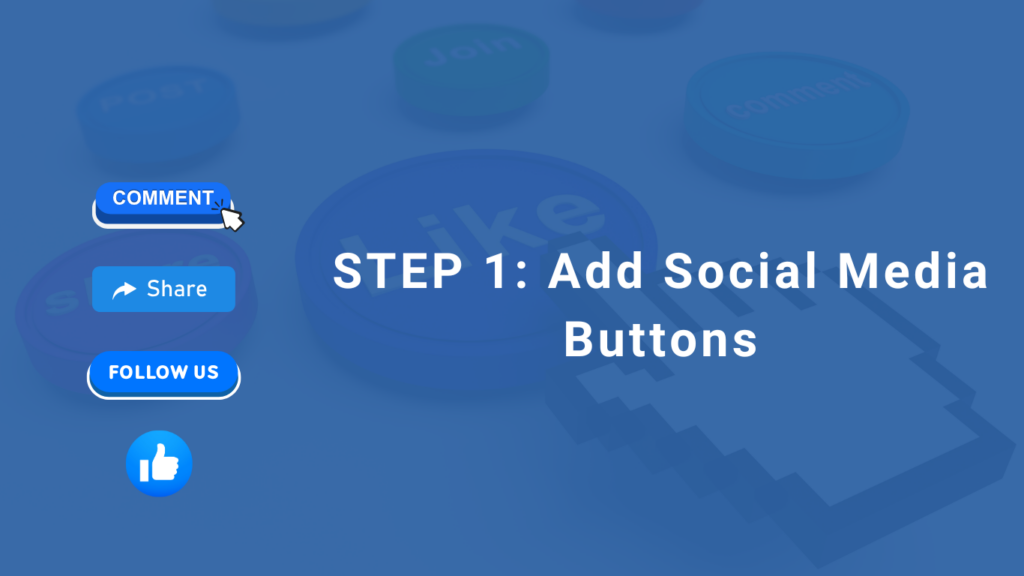Let’s be real ,social media isn’t just a passing trend. It’s a powerful tool that can make or break your online presence! If you’re looking to level up your website and attract more eyeballs, integrating social media is a must. But don’t worry; you don’t need to be a tech guru to get it right. Whether you’re a savvy business owner, a budding blogger, or someone who just wants their website to sparkle, I’m here to guide you through the steps on how to integrate social media into your website with a sprinkle of fun and zero stress.
In this article, we’ll explore creative ways to make your website feel like a party where social media is the VIP guest! From adding funky social share buttons to embedding real-time feeds that keep your site fresh. Let’s dive in and make it happen!

1. Add Social Media Buttons
The most basic and effective way on how to integrate social media into your website is by adding social media buttons. These small icons, typically located in the header, footer, or sidebars, allow visitors to easily connect with your profiles on social platforms such as Facebook, Instagram, Twitter, LinkedIn, and more.
You can place these buttons strategically across your website, ensuring they are visible without distracting your audience from the main content. The key is to keep it simple, too many icons can overwhelm visitors. Also, make sure these buttons are easily clickable and lead to the correct social media profiles. Adding social media buttons gives users an easy way to stay connected with you, and it’s a no-brainer for increasing your followers.
For example, if you’re running an e-commerce site, adding Instagram and Pinterest buttons can drive traffic to your visual product listings. Alternatively, a blog might benefit from sharing buttons that allow readers to post articles to their own social media pages.
2. Embed Social Media Feeds
Another creative way on how to integrate social media into your website is by embedding your social media feeds directly onto your site. This allows visitors to interact with your latest posts without having to leave your website. It’s a great way to showcase your content and build social proof. Visitors can see your most recent Instagram photos, tweets, or Facebook updates, making them feel more connected to your brand.
Embedding your social media feed helps keep your website fresh with real-time updates. You can add a Twitter feed to show your latest tweets or an Instagram feed to display photos from your account. These embedded feeds serve two purposes: they keep your website dynamic, and they encourage users to follow your social media accounts.
For example, a restaurant’s website can embed Instagram photos of its dishes, increasing interest and engagement. Similarly, a business can showcase customer reviews or posts on social media that highlight their products or services.
3. Enable Social Sharing Features
If you want visitors to share your content across their own social media profiles, enabling social sharing features on your website is a great option. Social sharing buttons allow visitors to quickly share blog posts, product pages, images, or videos with their followers. This can drive traffic to your website and expose your content to a wider audience.
Social sharing buttons should be placed strategically near your content. For blog posts, these buttons often appear at the beginning or end of articles. For product pages, you can include sharing options near product descriptions or images. Think of it as a way to encourage your audience to spread the word for you.
If you’re a business, a service provider, or even a content creator, enabling social sharing is an excellent way to increase visibility. For example, if you’re running a sale, you can add share buttons that make it easy for customers to share the discount with their friends.

4. Use Social Media Widgets
Social media widgets are another excellent way to integrate social media into your website. These widgets offer more interactive features, such as displaying recent tweets, Facebook reviews, or even Instagram stories, and they can enhance your website’s social presence. Widgets like these allow users to interact with your social media without leaving your website.
Social media widgets can be used to display your most recent content or show off user-generated content, such as customer reviews, which can help increase credibility and engagement. Plus, widgets can be easily customized to match your website’s design, making them both functional and stylish.
A good example of using social media widgets is embedding a Facebook Like Box or a Twitter timeline widget on your website. This shows live updates directly on your site, keeping visitors engaged with your social media activities.
5. Include Social Proof on Your Website
Social proof is one of the most powerful psychological principles in marketing. It’s based on the idea that people are more likely to trust and engage with something that others have already endorsed. Integrating social media into your website through social proof involves showcasing your followers, reviews, or testimonials from platforms like Facebook, Instagram, or Twitter.
You can feature these elements on your homepage, product pages, or in blog posts to build trust with your audience. For example, showing your number of Twitter followers or Instagram likes on your product page can help build confidence in potential buyers. Social proof can work wonders in nudging visitors to take action, whether that’s purchasing a product or subscribing to a newsletter.
A great example of social proof integration is a service provider displaying customer testimonials or Twitter posts about their business. This adds credibility to your site, increasing the likelihood of conversion.
6. Use Social Media to Drive User-Generated Content
User-generated content (UGC) is a goldmine when it comes to social media. It’s a powerful way to integrate social media into your website while encouraging your audience to engage with your brand. When customers or followers share content related to your brand, you can use this as authentic social proof on your site.
Encourage your customers or followers to share images, videos, reviews, or testimonials that you can showcase on your website. This not only provides fresh content but also creates a sense of community and loyalty. UGC can be used in blog posts, galleries, or even on product pages to show real-life examples of your products or services.
For example, a clothing brand can encourage users to share photos of themselves wearing the brand’s products with a branded hashtag, and then feature those posts on the website. This adds a personal touch, making your brand feel more relatable and authentic.

7. Run Social Media Contests and Giveaways
Contests and giveaways are an excellent way of integrating social media into your website while also boosting engagement. You can run a social media contest where users must engage with your social profiles (like, comment, share) and participate directly through your website. By making it a fun and interactive process, you’ll increase both website traffic and social media following.
The key to a successful social media contest is offering something valuable as a prize. It could be a product, a discount, or exclusive content. Once people participate, encourage them to visit your website to learn more about your brand or purchase your product. This strategy can drive traffic, increase engagement, and build excitement around your brand.
For instance, a local business might host a Facebook contest asking people to like their page and share a post to enter. You can integrate the contest directly on your website by creating a landing page to capture entries.
8. Make Your Content Social Media-Friendly
As you continue to think about how to integrate social media into your website, it’s important to make your content itself more shareable. This means ensuring your blog posts, images, videos, and product descriptions are easy for users to share on their social media channels. Shareable content drives more visibility and engagement.
Start by creating share-worthy headlines that grab attention and make visitors want to share your posts. Use high-quality visuals, such as infographics or eye-catching photos, to make your content stand out. Don’t forget about the formatting—use short paragraphs, bullet points, and call-to-action buttons that encourage users to share with their followers.
For example, a travel blogger might create a “Top 10 Destinations for 2025” blog post and make sure it’s optimized with shareable images, engaging captions, and social media buttons. This makes it easy for readers to share the content on their own social channels.
Conclusion:
Integrating social media into your website is a smart move for boosting engagement, expanding your audience, and improving your online visibility. As we’ve explored, there are many ways showcasing how to integrate social media into your website, from adding social sharing buttons to embedding social media feeds and using user-generated content.
The key is to strike the right balance between making social media accessible while ensuring it enhances the user experience. Integrating these strategies will not only make your website more engaging but will also help you drive more traffic and build a loyal following.
Remember, social media is a dynamic, ever-changing landscape. By keeping up with the latest trends and adapting your strategy, you’ll ensure your website stays relevant and your social media efforts continue to pay off. Start integrating these tactics today, and watch how they transform your online presence!
